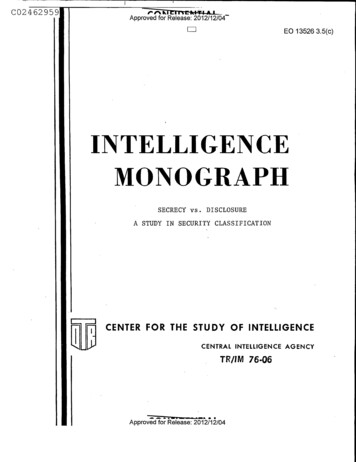
Transcription
r w C02462959Approved for Release: 2012/12/04EO 13526 3.5(c)INTELLIGENCEMONOGRAPHSECRECY vs. DISCLOSUREA STUDY IN SECURITY CLASSIFICATIONa CENTER FOR THE STUDY OF INTELLIGENCECENTRAL INTELLIGENCE AGENCYTR/1M 76-06Approved for Release: 2012/12/04
C02462959THE CENTER FOR THE STUDY OF INTELLIGENCE IN OTR OPERATESA RESEARCH AND DISCUSSION PROGRAM KEYED TO THE PROCESSESAND FUNCTIONS OF INTELLIGENCE. THE OBJECTIVE OF THE CENTERIS TO CONTRIBUTE TO THE PROFESSIONAL UNDERSTANDING ANDTO THE RECORD OF THE ART OF INTELLIGENCE. RESEARCH PROJECTSARE UNDERTAKEN BY INTELLIGENCE "FELLOWS"--VOLUNTEEROFFICERS FROM ACROSS THE AGENCY ON FULL-TIME DETAIL TOTHE CENTER. INQUIRIES ABOUT THE CENTER PROGRAM, OR COMMENTSON THIS REPORT ARE INVITED BY THE DIRECTOR/CSI, EXTENSION 2193.Classified by184,Exempt from general declassificaion scheduleof E.O. 11652, exemption category:§ 5B(21Automatically declassified on:date impossible to detarmine
CO2462959Approved for Release: 2012/12/04TABLE OF CONTENTSPageINTRODUCTIONiPRINCIPAL CONCLUSIONS AND RECOMMENDATIONSvDEVELOPMENT OF THE CLASSIFICATION SYSTEM1Criticism of the Classification SystemTHE FUNCTIONING OF CLASSIFICATION WITHIN CIAMisclassificationRelated IssuesReasons for MisclassificationAnomalies in the Handling of Top SecretMaterialExemption, Downgrading, DeclassificationImpact of Freedom of Information andPrivacy ActsScope of Noncompliance with E.O. 11652Effect of Classification on CIATHE PROBLEM OF DISCLOSUREThe Protection of Sources and MethodsStatutory and Constitutional Barriersto Disclosure4121317212326303437424251CONCLUSIONS AND RECOMMENDATIONS60FOOTNOTES80ANNEX A - CLASSIFICATION CRITERIA94ANNEX B - PRINCIPAL CHANGES EFFECTED BYE.O. 11652102ANNEX C - BREAKDOWN OF THE CLASSIFICATIONOF THIS STUDY105Approved for Release: 2012/12/04
C02462959Approved for Release: 2012/12/04CONFSECRECY VS. DISCLOSURE - A STUDY INSECURITY CLASSIFICATION"We have an obligation toprovide as much informationas possible on an unclassified basis, but withoutderogation of the necessityto protect sensitive sourcesand methods and to protectinformation which trulyrequires sensitive treatment."Director of Central IntelligenceGuiding P,%inciptee bon theIhteZtigenee Community.INTRODUCTIONThis Study is the first in a series undertaken by the1Center on the subject of compartmentation,the basic purposeof which in the Agency and elsewhere is to preserve secrecy.The principal technique for doing this, the ,one on which theothers repose, is the federal classification system.ThisStudy looks first at the historical development of classification, seeking to isolate its endemic problems and to gain afresh perspective on a procedure that has become hackneyedfor most of us.The Study then focuses on classificationpractices within CIA--a major factor in Agency compartmentation.iC0 zgj Approved for Release: 2012/12/04
C02462959Approved for Release: 2012/12/04It also looks at the interrelationship of classificationand the Freedom of Information and Privacy Acts, at thestatutory protection of sources and methods, and at theother legal barriers to the disclosure of foreign intelligence information.*The preservation of secrecy throughclassification and the other techniques of compartmentationultimately depends on the legal power to withhold information and to deter unauthorized disclosure.The protection of classified information in our societyhas always involved a tug of war between the conflictingrequirements of secrecy and publicity.From the earliestdays there has been conflict between the Executive and theLegislature over Executive confidentiality.Events, moreover,since the adoption of the present classification system in1972--particularly Vietnam, Watergate, and various disclosuresand investigations--have intensified these historical tensions,generating, both inside and outside the government, sharp*The author of this Study wasassistedby the staff and fellows of t e enter or t e Study of Intelligence.The methodology of the Study involved interviewing keypersonnel in the Agency involved with classification and relatedmatters and extensive research in the available literature.Congressional hearings and studies are the most important sourceo the latter. Although there have been numerous studies ofcodeword compartmentation within CIA and the IntelligenceCommunity, we are not aware of any single, published, comprehensive study of the classification system done within theIntelligence Community.We have, therefore striven for comprehensiveness in the Study both as a means of solving the immediateproblems at hand and of facilitating the further research ofothers concerned with classification.iiApproved for Release: 2012/12/04
C02462959Approved for Release: 2012/12/04CONFTDVWT4AJcriticism of classification practices.Whenever classificationdecisions have lacked an aura of credibility for Congress andthe public, the information they protected.has been vulnerableto disclosure.No statute or Executive order has long sufficedto protect information that Congress or the public has come toregard as pseudo-secrets or cover-up of illegality.The amendedFreedom of Information Act (FOIA) and the Privacy Act havebrought the executive branch to the realization that in ademocracy the "right to know" of Congress and the public isjust as imperious as the "need to know" of the bureaucrat.This counterpoint between secrecy and disclosure and, in aclosely related sense, between secrecy and publicity, is themain theme of this Study.The developments referred to above have led the executivebranch to reexamine the full implications of secrecy and classification.National Security Study Memorandum (NSSM) 229,dated 16 August 1975, created an ad hoc interagency group,under the chairmanship of the Deputy Assistant to thePresident for National Security Affairs, charged withmaking a comprehensive study of the classification systemand submitting, if appropriate, recommendations for therevision of E.O. 11652 and possible legislation on themanagement of classified information.Symptomatic of CIAconcern with classification problems was the establishmenton 13 January 1976 of an interagency group chaired byiiiApproved for Release: 2012/12/04
CO2462959Approved for Release: 2012/12/04CO DEIV' Pi- Dr. Edward Proctor, charged with finding "a basis for designinga simplified classification system which will provide the necessary protection of intelligence sources and methods and willfacilitate access to the results of the intelligence processby all consumers who need the intelligence product."*Finally,E.O. 11905, issued 18 February 1976, directed the DCI "toestablish a vigorous program to downgrade and declassifyforeign intelligence information as appropriate and consistentwith E.O. 11652."The Center hopes that this Study will contribute to theefforts of those officers engaged in carrying out the aboveorders and will be of use to others interested in the impactof a vital adjunct of the intelligence process within the CIA.A summaryOfits principal conclusions and recommendations isset forth in the next section.(The full text of the recom-mendations is contained in the final section.)*In an effort to provide an independent perspective on classification problems, this Study has not been linked with theresults of the Proctor group.ivApproved for Release: 2012/12/04
C02462959Approved for Release: 2012/12/04ADMINIST-PRINCIPAL CONCLUSIONS AND RECOMMENDATIONSThroughout the history of the classification system,going back even to its nineteenth century precursors, certainnegative traits--overclassification, unnecessary classification, vagueness of the classification criteria, and accumulation of vast quantities of classified paper--have always beenpresent.Unfortunately, they are all part of the classifica-tion experience of the CIA today.In recent years, thenegative traits have attracted public and congressionalattention and have resulted in a series of studies, regula-tions, and reforms intended to improve the system.Therehas been some improvement, but not much.- Although recognizing the primary responsibilityof the National Security Council and the ICRCin the area of classification, this Study recommends that CIA take a leading role in the development of classification theory and in the reformIn thisof the present classification system.sense, six recommendations are offered in theStudy for the reform of E.O. 11652.Their principal thrust is to:- increase the specificity of the classificationcriteria,- prevent misclassification for reasons ofadministrative privacy,- replace the ICRC with a greatly strengthenedinteragency classification board,- restrict the establishment of compartmentsthat have repercussions beyond the originatingdepartment, andvAD.Approved for Release: 2012/12/04
C02462959Approved for Release: 2012/12/04ADMINISTRATIVE - INTERNAL USE ONLYraise the level of classification-consciousnessthroughout the government.The Study finds significant Agency noncompliance withthe provisions of E.O. 11652.The principal areas are over- 'and unnecessary classification, excessive use of the exemption provision, and anomalous handling of Top Secret cables.Due to bureaucratic pressures and the force of precedent,classification errors made in the past tend to be perpetuated.Original classifiers, who are usually busy supervisors, oftenabdicate their classification responsibilities to subordinates.The "play-if-safe" mentality is a powerful contributing factorto overclassification.As remedies, the Study recommends:- the establishment of a CIA Classification Boardto replace the present CIA Information ReviewCommittee,- new guidance and stepped-up training inclassification,- the beginning of classification of documentsby section or paragraph,- the preparation of internal CIA guidelines forde novo classification of information takenfrom raw reports for use in finished intblligence,- the handling of Top Secret cables in the samemanner as other Top Secret collateral material,- the abolition of pre-printed Secret forms,- a thorough review of the number and level ofauthorized classifiers within the Agency,- a new regulation on administrative privacy,- research into means of controlling the reproduction of classified paper.viADMINISTRATIVE - INTERNAL USE ONLYApproved for Release: 2012/12/04
C02462959Approved for Release: 2012/12/04ADMINISTRAT-In assessing the effect of the classification system onday-to-day operations within CIA, the Study concludes that,except for Top Secret, the flow of information within theAgency, even when accompanied by overclassification, is onlyslightly impeded in reaching proper users.- But the cumulative effects of overclassificationare more insidious:Bad secrets devalue goodones, setting in motion a process of escalatingprotection for the "real" secrets which drainsthe classification criteria of their prescribedmeaning.- The regular classification categories have thusbecome the underpinning for a vast superstructureof supplementary protection.The latter includesnot only the codeword compartments, but also thearray of document control markings and the minicompartments employed by the Operations Directorateto protect sources and methods.The computer system of the Central Reference Service (CRS)recognizes some 1400 combinations of document control markings.The latter not only complicate retrieval of information, butsometimes preclude it altogether when, for reasons of sensitivity,documents are not indexed in the Agency's central referencesystem.- The Study concludes that a DDO dissemination,stamped Secret and invested with some of themore restrictive handling controls, probablyenjoys greater protection than the averageTop Secret collateral or Top Secret codeworddocument.These access-limiting and distribution-control devices, and the special handlingdevices within the DDI, have a very tangibleeffect on the flow of information within theAgency.viiADMINISTRATIV-Approved for Release: 2012/12/04
C02462959Approved for Release: 2012/12/04ADMINISTRAT. IV-- Although not taking a stand against these techniques, the Study points out that the lack offormal criteria for their use and their irregularapplication sometimes deprive analysts and operatorsof the information they need to do their job.FOIA and the Privacy Act are having a significant impacton the Agency and on the functioning of the classificationsystem within the Agency.The statutory and judicial aspectsof these Acts place a premium on strict compliance with theclassification and exemption provisions of E.O. 11652 and onquick discernment of overclassification in disputed cases.In the long run, they should have a corrective influence onclassification abuses.After examining the origins and judicial history of thesources-and-methods provision of the 1947 National SecurityAct, the Study concludes that, as it stands, the provision isan imperfect vehicle for protecting intelligence informationfrom disclosure.Other statutory and constitutional barriersto disclosure are also examined and found wanting.- The Study judges that the Atomic Energy Act of1954 establishing the category of "RestrictedData" is perhaps the most successful securityprogram in the government and may have valueas a paradigm for statutory protection offoreign intelligence information.The Study recommends, after reviewing legislative proposals for establishing a statutory classification system, aswell as proposals for codifying the Espionage and relatedstatutes and for strengthening the sources-and-methodsviiiADMINISTRATIVEa- Approved for Release: 2012/12/04aid
C02462959Approved for Release: 2012/12/04ADMINISTRATIVE -provision, that the Agency sponsor legislation amending thesources-and-methods provision, defining it, and establishinga new category of legally protected information, overlappingwith, but independent of, the classification system.- It recommends finally that the DCI, actingwithin the NFIB structure, create a committeeof legal experts to study the revision of theEspionage Statutes.11ixADMINISTApproved for Release: 2012/12/04
C02462959Approved for Release: 2012/12/04DEVELOPMENT OF THE CLASSIFICATION SYSTEMInformation has been protected in one way or another fromthe very beginning of this country.The Constitutional Con-vention of 1787 conducted its proceedings in secret, and notuntil 1920 were the records of the Convention made public.The 1775 Articles of War, and legislation since 1776, haveprohibited soldiers from corresponding with the enemy andcivilians from spying in wartime.During the Civil War, the government suspended habeascorpus, made numerous political arrests, and censored thepress.After the Civil War, there was a gradual recognitionof the importance of protecting military installations andthe information concerning them from the prying eyes offoreign intelligence.Up to World War I, there was onlyone "classification"--Confidential--used to designate certaintypes of defense information requiring protection.But,unlike its modern namesake, the word "Confidential" had noprescribed meaning in terms of the contents of a document,but was rather a means of limiting the distribution tospecified addressees or categories of addressees.Nor wasit generally used to stamp documents.Influenced by British and French example, the AmericanExpeditionary Force in 1917 adopted multiple levels of classification--Secret, Confidential,For Official Circulation1Approved for Release: 2012/12/04
C02462959Approved for Release: 2012/12/04Only--which were soon incorporated in War Department Regulations.But the use criteria for these document markings were based ona vague determination that a given piece of information was"more or less secret" and on a prescribed narrowing of theaddressees according to the determined level of sensitivity.Though some see in this World War I experience the beginningsof the present classification system, its lineaments are muchclearer in the 1936 revision of Army Regulations, No. 330-5,where, for the first time, the levels of classification weredefined in terms of damage to national security, and theprotection of the markings was extended to non-defenseinformation affecting national security.The category,Restricted, however, which had now replaced Official UseOnly, was really not a national security marking but rathera means of ensuring administrative privacy.Although there are no close parallels to the presentclassification system in the pre-World War I period, thereare nevertheless archetypes of several closely relatedsecurity practices still in vogue today.Thus, GeneralOrders, No. 3 of the War Department, 16 February 1912,prescribed these measures for safekeeping military recordsconcerning seacoast defenses:They were to be "classed" asConfidential, kept under lock, given serial numbers, logged,subject to copy control, shown only to "trusted employees"according to the "exigencies of service."2Approved for Release: 2012/12/04War Department
C02462959Approved for Release: 2012/12/04Regulations of 1913 ordered double wrapping of telegrams andother communications, with Confidential stamped on the innerenvelope only.The Chief of Artillery complained bitterlyin 1907 about the indiscriminate use of Confidential on Armyissuances, citing in particular one that contained the formulafor making whitewash.(This is perhaps the first documentedinstance of "unnecessary" classification.)While the military were protecting their secrets by meansof classification, the State Department, up to 1958, was stillrelying on the "housekeeping" statute of 1789 to protect diplomatic secrets.The first Executive order dealing with clas-sification, President Roosevelt's E.O. 8381 of 1940, wasessentially a wartime measure and had no lasting influenceon classification.President Truman's E.O. 10290 authorizedany government agency to classify "official information thesafeguarding of which is necessary in the interest of nationalsecurity and which is classified for such purposes by appropriateclassifying authority."Because of the vagueness of the"national security" standard, Truman's order was immediatelyattacked as an infringement of the First Amendment.It was superseded two years later by President Eisenhower'sE.O. 10501, issued 5 November 1953, which lasted almost twentyyears until replaced by the present system.It redefinedConfidential, Secret, and Top Secret, reduced the number of3Approved for Release: 2012/12/04
C02462959Approved for Release: 2012/12/04agencies authorized to classify, and set a twelve-year limit,subject to some exceptions, on maintenance of information inthe Top Secret category.President Kennedy in 1961 (E.O. 10964)2added provisions for automatic downgrading and declassification.President Nixon ushered in the present system on 8 March 1972with E.O. 11652 entitled, "Classification and Declassificationof National Security Information and Material."A National Security Council Directive implementing thisOrder was issued on 17 May 1972.The Order itself, which tookeffect on 1 June 1972, refined the criteria for the threelevels of classification, replaced the "national defense"formulation of E.O. 10501 with that of "national security,"a collective term for "national defense" and "foreign relations,"established a general declassification schedule with fourexemptions, and created an Interagency Classification ReviewCommittee (ICRC) to assist the National Security Council3(NSC) in monitoring the system.Criticism of the Classification SystemIt is hardly an exaggeration to say that the classification systems created by Executive order have been under almostcontinuous attack by Congressional and other bodies sincetheir inception.The chief critic has been the House Sub-committee on Information, established in 1955, and joined4Approved for Release: 2012/12/04a
C02462959Approved for Release: 2012/12/04later in that role by the Senate Subcommittee on Intergovernmental Relations.The Freedom of Information and Privacy Actswere by-products of this close monitoring of government secrecy.A principal target of the House subcommittee in its early yearswas the functioning of the classification system within theDepartment of Defense.Reacting to Congressional pressure,the Pentagon established the Coolidge Committee to conductan in-house investigation.This committee, and others since,directed attention to shortcomings that are still evident inclassification practices today.In its report, the Coolidge Committee concluded that thetwo major shortcomings of the system at that time were over-classification and deliberate unauthorized disclosure.Thelatter was a reference to the spate of disclosures promptedby interservice rivalry.The report found a tendency on thepart of Pentagon officials to "play-it-safe" and overclassify;abuse of security in the classification of administrativematters; attempts to classify the unclassifiable; confusionstemming from classification procedures that were based onshifting foreign policy; and a failure to declassify material4that was no longer secret.Reflecting the security concerns of the McCarthy era,the Congress in 1955 established a Commission on GovernmentSecurity (known as the Wright Commission) that included5Approved for Release: 2012/12/04
C02462959Approved for Release: 2012/12/04classification among the subjects it investigated.The sectionof the Commission's 807-page report., issued in 1957, dealingwith classification, recommended "that the Confidential classification be abolished.The Commission is convinced thatretention of this classification serves no useful purposewhich could not be covered by the Top Secret or Secret classification."It based this recommendation on a finding thatoveruse of Confidential was impeding the free exchange ofscientific and technical information and thus hamperingnational security.(As will be seen in a later section,the abuse of Confidential then was similar to the abuse ofthe Secret label now.)The Commission urged also the enactment of legislationmaking it a crime to release to an unauthorized person information classified Secret or Top Secret, knowing it to havebeen so classified, for any reason whatsoever.The bill wasaimed at persons outside the government, such as newsmen,6and aroused a storm of protest.Noting that there were1.5 million employees in the government authorized toclassify documents, the Commission also recommended a majorreduction in the number of classifiers.Meanwhile, the House Subcommittee on Information (knownas the Moss Committee after its first Chairman, RepresentativeJohn E. Moss), having finished its investigation, deliveredApproved for Release: 2012/12/04It
C02462959Approved for Release: 2012/12/04its report in June 1958.The following excerpt is indicativeof the tenor of the report:In a conflict between the right to know andthe need to protect true military secrets from apotential enemy, there can be no valid argumentagainst secrecy.The right to know has suffered,however, in the confusion .over the demarcationbetween secrecy for true security reasons andsecrecy for "policy" reasons.The properimposition of secrecy in some situations isa matter of judgment. Although an officialfaces disciplinary action for the failure toclassify information which should be secret,no instance has been found o an official beingdisciplined for classifying material which shouldhave been made public.The tendency to "play itsafe" and use the secrecy tamp, has, therefore,been virtually inevitable.The committee's recommendations, many subsequently embodied inthe present E.O. 11652, called for a reduction in the numberof classifying agencies and individual classifiers, an accelera-tion of the process of downgrading and declassifying, and8establishment of an appeals procedure against misclassification.The final days of E.O. 10501 were characterized by spectacular leaks and acute administrative difficulties.InJune 1971, a Top Secret study on Vietnam, the "PentagonPapers," was published with impunity.This was undoubtedlythe most flagrant and brazen violation of security in thehistory of the American classification system.That muchof it was overclassified and that one would be hard put toprove that the disclosure caused "exceptionally grave damageto the nation" (to measure it against the then criterion for7Approved for Release: 2012/12/04
C02462959Approved for Release: 2012/12/04Top Secret) is beside the point.In December 1971, there wasa leak in connection with the India-Pakistan war; in early1972, a National Security Council memorandum revealing policyconflicts over Vietnam war strategy appeared.All threeinstances exemplify unauthorized disclosure motivated byopposition to government policy.Their counterpart, andperhaps their inspiration, was the executive branch practiceof selective disclosure and premeditated leaking to promotegovernment policy.On the administrative side, Congressman William S.Moorhead, the new Chairman of the Subcommittee on GovernmentOperations and Government Information, referred to "mountainsof classified documents" that had accumulated, contending that"the inevitable was finally recognized in early 1971 as massiveoverclassification and other abuses of the system created aclassification crisis and the virtual breakdown of our system."Although one can doubt that the situation was as cataclysmic as this, it was sufficiently serious to promptPresident Nixon to appoint, on 15 June 1971, an interagencycommittee charged with making a searching review of theclassification system.The committee was headed by thenAssistant Attorney General, William H. Rehnquist.Aftermore than a year of study, the committee, early in 1972,presented a draft issued shortly thereafter as ExecutiveOrder 11652.8Approved for Release: 2012/12/049
C02462959Approved for Release: 2012/12/04Since the issuance of E.O. 11652, Congressional criticism10(These points havehas made such points as the following:figured prominently in the Congressional hearings on classification and, as we shall see further on, some of them arereflected in proposed legislation.The Freedom of Informationand Privacy Acts., also discussed below, embody some of thethinking implicit in these criticisms.)- "It confuses the legal meaning of the term'national defense' and 'national security'and the terms !foreign policy' and 'foreignrelations' while failing to provide anadequate definition of these terms." (Thereference is to the use of the term "nationalsecurity" in E.O. 11652 in place of "nationaldefense" used in E.O. 10501 and similar wordingin Exemption (b)(1) of the Freedom of Information Act:"matters under Executive orderrequired to be kept secret in the interest ofnational defense or foreign policy.")- There are no specific penalties for overclassification and unnecessary classification.- It permits defense and foreign policy errorsto be concealed for at least three 4-yearPresidential terms, and up to 30 years orlonger under the exemptions.The ICRC is not accountable to Congress.Section 9 legitimizes and broadens authorityfor the use of special categories of "classification governing access and distributionbf classified information beyond the threespecified categories."(This refers to theauthorization of supplementary protectionsuch as codeword compartments and documentcontrol markings.)- An independent regulatory body, with administrative, enforcement, and adjudicatory9Approved for Release: 2012/12/04
C02462959Approved for Release: 2012/12/04powers, should be established in the executivebranch to police all aspects of the classification system.- A statutory classification system should replacethe practice of Executive orders governingclassification.Congressional critics of the classification system havepaid particular attention to the number of authorized classifiers.Seeing a causal connection between the expandingvolume of classified information and the number of classifiers, they have demanded sharp reductions in the number ofthe latter.Thus, the executive branch was induced to reducethe number of classifiers from 1.5 million in 1957 to 55,000in 1971, the year prior to the issuance of E.O. 11652.The55,000 figure consisted of'2,849 Top Secret classifiers,1118,029 Secret, and 34,122 Confidential.(The CIA figuresfor classifiers, given below, are the reverse of these, withthe Confidential category being the smallest and the Secretthe largest.)But there is little evidence of a corresponding declinein the birth rate of classified paper.*Actually, no oneknows the exact number of classified documents in the executive branch, not even the number of Top Secret ones.the order of magnitude is ascertainable.ButHearings of the*We note, however, that the ICRC Progress Report for 1975claims a 2 percent reduction in the number of classificationactions in 1974 and 6 percent in 1975.10Approved for Release: 2012/12/04
C02462959Approved for Release: 2012/12/04House Subcommittee on Information in 1971 and 1972 provide somebench marks:William G. Florence, a retired Air Force clas-sification official, estimated that the Defense Department hadat least 20 million classified documents and was of the opinionthat 99 percent of them did not merit classification in termsof a strict interpretation of the Executive order.A StateDepartment witness gave an estimate of 35 million classifieddocuments for his department.And Dr. James B. Rhoads, theUnited States Archivist, said he was responsible for 470 million12pages of classified material covering the period 1939-1954.It would probably be safe to say that total classified holdingsof the executive branch at this time have long since passedthe billion mark.There are grounds, therefore, for questioning the assumption that limiting the number of classifiers necessarilyrestrains the accumulation of classified paper.As indicatedlater in the CIA context, strong bureaucratic forces tend toundercut this assumption.11Approved for Release: 2012/12/04
C02462959Approv
Study looks first at the historical development of classifica-tion, seeking to isolate its endemic problems and to gain a fresh perspective on a procedure that has become hackneyed for most of us. The Study then focuses on classification practices within CIA--a major factor in Agency compartmentation. i C0 zgj _









